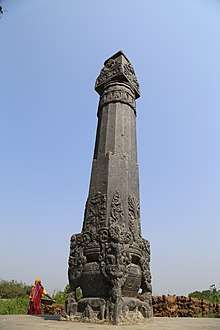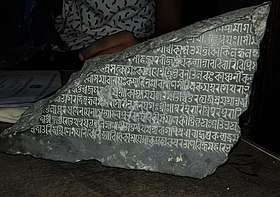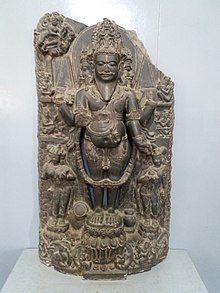Karnat dynasty
The Karnat or Karnata Dynasty originated with the establishment of a kingdom in 1097 CE. The dynasty had two capitals which were Simraungadh in Bara District of Nepal and Darbhanga, Bihar which became the second capital during the reign of Gangadeva.[1] The kingdom controlled the areas we today know as Tirhut or Mithila in Bihar state of India and Nepal. This region is bounded by the Mahananda River in the east, the Ganges in the south, the Gandaki River in the west and by the Himalayas in the north.[2][3] Under the Karnats, Mithila enjoyed almost full sovereignty from 1097 until 1324.[4]
Karnatas of Mithila | |
|---|---|
| 1097 CE–1324 CE | |
| Capital |
|
| Religion | Hinduism |
| Historical era | Medieval India |
• Established | 1097 CE |
• Disestablished | 1324 CE |
According to French orientalist and indologist Sylvain Lévi, Nanyadeva established his supremacy over Simraungadh probably with the help of Chalukya king Vikramaditya VI.[5][6][7] After the reign of Vikramaditya VI in 1076 CE, he led the successful military campaign against the Pala dynasty and the Sena dynasty.[8][9] During the reign of Harisimhadeva, the Karnats also carried out raids into Nepal with the Karnat army under the leadership of the general and minister, Caṇḍeśvara Ṭhakkura.[10]

Origins
The exact origins of the Karnatas of Mithila are still up for debate, however Sena dynasty inscriptions refer to Nanyadeva as Karnata-Kulabhusana indicating that he had his origins in the South and likely arrived in the North as part of the Chalukya invasions. His ancestors were petty chieftains and adventurers in Eastern India and Nanyadeva carved out his own kingdom in Mithila.[11]
When Nanyadeva first arrived in the region in 1093 A.D., he originally established his stronghold in Nanapura in Champaran of Bihar and referred to himself as Mahashamantadhipati as confirmed by the local traditions of Mithila. The title suggests that he was likely originally a commander in the Chalukaya army. He later shifted his capital to Simraungadh.[12]
Downfall
Harisingh Dev (r. 1295 to 1324 CE), the sixth descendant of Nanyadeva was ruling the Tirhut Kingdom. At the same time the Tughlaq dynasty comes to power, which ruled the Delhi sultanate and whole Northern India from 1320 to 1413 CE. In 1324 CE, the founder of the Tughlaq dynasty and Delhi Sultan, Ghiyasuddin Tughlaq turned his attention towards Bengal.[10] The Tughlaq army invaded Bengal and on his way back to Delhi, The sultan heard about the Simraungarh which was flourishing inside the jungle.[13] The last king of the Karnata dynasty Harisingh Dev didn't show his strength and left the fort as he heard the news of approaching army of the Tughlaq Sultan towards the Simraungarh.[14] The Sultan and his troop stayed there for 3 days and cleared the dense forest. Finally on day 3, the army attacked and entered into the huge fort whose walls was tall and surrounded by 7 big ditches.[15][16]
The remains are still scattered all over the Simroungarh region. The king Harisingh Deva fled northwards into the then Nepal. The son of Harisingh Dev, Jagatsingh Dev married the widow princess of Bhaktapur Nayak Devi.[17]

Legacy
Under the Karnatas, Mithila experienced a period of relative peace which allowed for authors, poets and artists to receive royal patronage. The Maithili language grew strongly during this period as new literature and folk songs were created. The philosopher, Gangeśa Upādhyāya, introduced the Navya-Nyāya school of thought which remained active in India until the 18th century. The general religious attitude of the people was conservative and the priestly aristocracy of Maithil Brahmins dominated the royal court.[18] The Varna Ratnakara of Jyotirishwar Thakur was also composed during the reign of Harisimhadeva.
Rulers
The rulers of Karnat dynasty are as follows:
| S.N. | Name of the rulers | Timeline | Notes |
|---|---|---|---|
| 1 | Nanyadeva.[19] | 1097 - 1147 CE[20] | |
| 2 | Gangadeva[19] | 1147 - 1187 CE[20] | |
| 3 | Narsimhadeva[19] | 1187 - 1227 CE[20] | |
| 4 | Ramasimhadeva[19] | 1227 - 1285 CE[20] | |
| 5 | Shaktisimhadeva[19] | 1285 - 1295 CE[20] | |
| 6 | Harisimhadeva[19] | 1295 - 1324 CE[20] |
Descendants
It is said that after his defeat, Harisimhadeva fled to Kathmandu where his descendants became the founders of the Malla dynasty of Kathmandu. The Mallas were noted as great patrons of the Maithili language.[21]
It is also said that another branch of the Karnats remained in Mithila and their descendants became the Gandhavariya Rajputs of North Bihar who held many chiefdoms in the region.[22][23]
Architecture

Inscriptions and artefacts related to Karnat dynasty have been found throughout the Mithila region including in both Simraungadh and Darbhanga. From Simraungadh, steles have been recovered that resemble Pala-Sena art. This was likely due to the close contact the Kingdoms had with each other due to being neighbours with allowed for cultural exchange. Many of these steles depict various Hindu goddesses and are typical of the Bihar production of the second half of the 12th century, especially in relation to the ornaments.[24]
References
- CPN Sinha (1974). "A Critical Evaluation of sources for identification of Gangeyadeva of Tirabhukti". Proceedings of the Indian History Congress. 35: 39–42. JSTOR 44138754.
- Jha, M. (1997). "Hindu Kingdoms at contextual level". Anthropology of Ancient Hindu Kingdoms: A Study in Civilizational Perspective. New Delhi: M.D. Publications Pvt. Ltd. pp. 27–42. ISBN 9788175330344.
- Mishra, V. (1979). Cultural Heritage of Mithila. Allahabad: Mithila Prakasana. p. 13.
- Pankaj Jha (20 November 2018). A Political History of Literature: Vidyapati and the Fifteenth Century. OUP India. ISBN 978-0-19-909535-3.
- Magazine, New Spolight. "Sylvain Lévi's Le Népal". SpotlightNepal. Retrieved 2019-04-15.
- Majumdar, Ramesh Chandra (1957). The Struggle For Empire. Bharatiya Vidya Bhavan, 1957. p. 47.
- Levi, Sylvain (2015-02-18). Le Népal: Étude Historique D'Un Royaume Hindou - Scholar's Choice Edition. Creative Media Partners, LLC. ISBN 9781297173240.
- Somers, George E. (1977). Dynastic History Of Magadha. Abhinav Publications. ISBN 9788170170594.
- Mukherjee, Ramkrishna; Mukherjee, Roopali (1974). Rise and Fall East India. NYU Press. ISBN 9780853453154.
- Choudhary, Radhakrishna (1970). History of Muslim rule in Tirhut, 1206-1765, A.D. Chowkhamba Sanskrit Series Office. p. 61.
- Sinha, CPN (1969). "Origin of the Karnatas of Mithila - A Fresh Appraisal". Proceedings of the Indian History Congress. 31: 66–72. JSTOR 44138330.
- Shrestha, Shiv Raj. "Nanyadeva, his ancestors and their Abhijana (Original Homeland)" (PDF). Cite journal requires
|journal=(help) - Thapa, Netra Bahadur (1981). A Short History of Nepal (PDF). Ratna Pustak Bhandar. pp. 38–39.
- Abdusi Akhsatan Dehlavi, Mohammad bin Sadr Taj (1301–1335). "Basatin-Ul Uns". Center for Persian Research: XXI. Cite journal requires
|journal=(help) - Abdul Malik Isami (1981). "Futuh-us-Salatin". University of Madras: 38–39. Cite journal requires
|journal=(help) - CPN Sinha (1970). "Decline of the Karnatas of Mithila". Proceedings of the Indian History Congress. 32: 79–84. JSTOR 44141053.
- "Simroungarh | Nepal | Heritage & Archaeological Site".
- Sinha, CPN (1973). "Some aspects of cultural life of Mithila under the Karnatas (c. 1097 to 1325 A.D.)". Proceedings of the Indian History Congress. 34: 170. JSTOR 44138616.
- Hodgson, B. H. (1835). "Account of a Visit to the Ruins of Simroun, once the capital of the Mithila province". Journal of the Asiatic Society. 4: 121−124.
- Chaudhary, Radhakrishna. Mithilak Itihas [मिथिलाक इतिहास] (in Hindi). Ram Vilas Sahu. pp. 70–112. ISBN 9789380538280.
- Brinkhaus, Horst (1991). "The Descent of the Nepalese Malla Dynasty as Reflected by Local Chroniclers". Journal of the American Oriental Society. 111 (1): 118–122. doi:10.2307/603754. JSTOR 603754.
- P. Pathak (1983). "Origin of the Gandhavaria Rajputs of Mithila". The Journal of the Bihar Puravid Parisad. Vii And Viii: 406–420.
- Bindeshwari Prasad Sinha (1974). Comprehensive History Of Bihar Vol.1; Pt.2. Retrieved 8 January 2019.
- Cimino, Rosa Maria (1986). "Simraongarh: The Forgotten City and its art". Contributions to Nepalese Studies. 13: 277–288. Retrieved 7 August 2020.